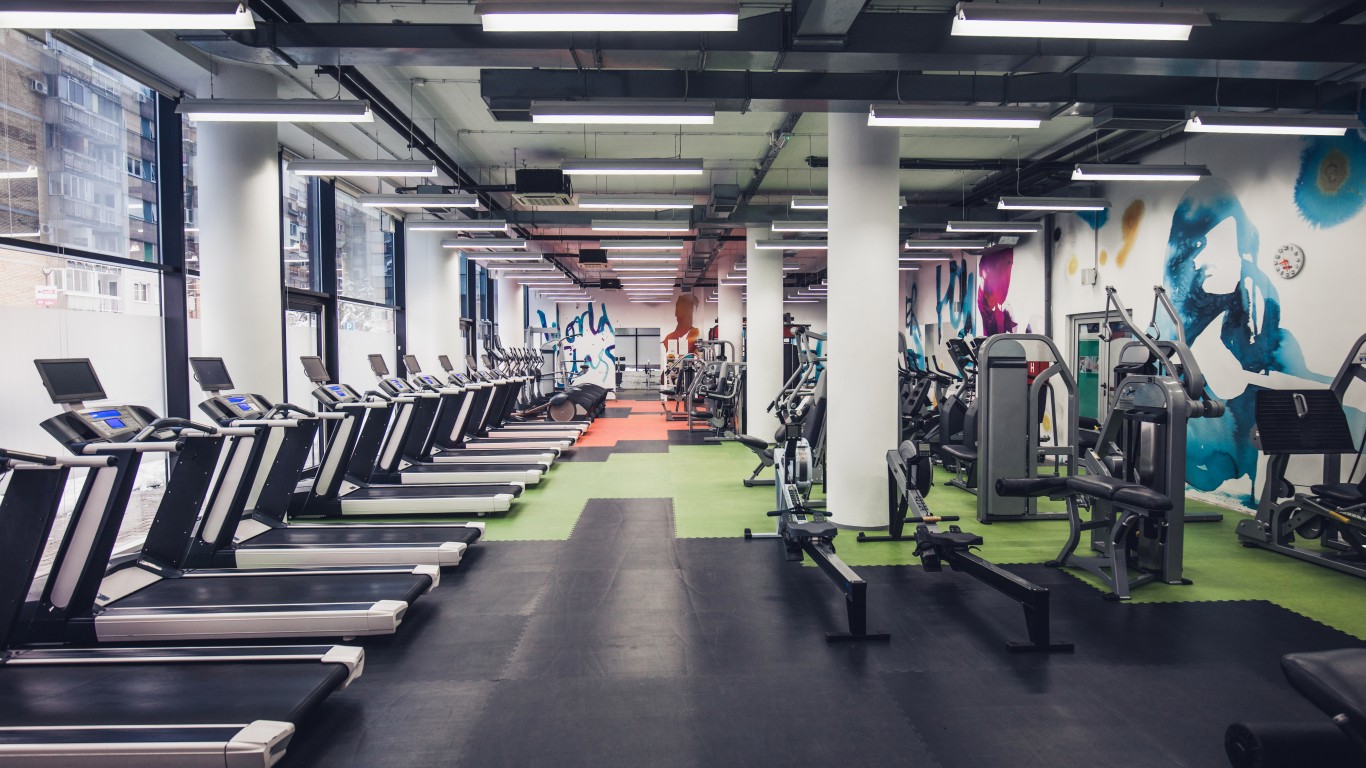
Businesses have been hit with a continuous stream of challenges since the beginning of the COVID-19 pandemic. While life has mostly returned to some semblance of normalcy, many U.S. businesses are still dealing with supply chain issues, staffing shortages, inflation, and looming recession fears. Some industries have been hit harder, but overall, an estimated 37% of small and medium businesses cannot pay their rent.
To identify the industries that cannot afford to pay their rent, 24/7 Wall St. reviewed Alignable’s report, Record Surge In Rent Delinquency: Up 7% In October, Totaling 37% For U.S. SMBs. The report listed industry rent delinquency rates for small and midsize businesses for each month of 2022 so far. Alignable based its rent delinquency estimates on a survey of 4,789 randomly selected businesses from Oct. 15, 2022 to Oct. 27, 2022.
Businesses are facing a variety of economic problems, some of which hit certain industries hard. During the height of the pandemic there was a large expansion of the at-home economy — people cooked, cut their hair, and worked out at home. As inflation continues to erode consumer purchasing power and recession looms, many people have already returned to these cheaper at-home alternatives, hurting businesses again. (Fight inflation, don’t buy these 9 items.)
Further, inflation and supply chain problems make doing business more difficult for almost every industry. These problems have been created by a myriad of problems, including the war in Ukraine and the “zero-COVID” policy in China.
Russia’s invasion of Ukraine has caused shortages in fuel, grain, fertilizer and more, driving up prices and creating issues for businesses that use them. China’s “zero-COVID” policy has put major factories and trading centers in the country on total lockdown, creating stark and unpredictable supply shortages. Many manufacturers require special parts that are produced in China. Delays can increase costs and result in the loss of customers.
Inflation is also driving up the cost of rent for businesses. An estimated 51% of small and midsize businesses surveyed reported a rent increase. And while some businesses have reported growing sales, the effects of inflation have absorbed much of their gains in sales. (Here’s what’s getting more expensive at stores in America)
All these factors have created a storm that is hitting some industries particularly hard.
Click here to see the industries with the most struggling small business owners.

12. Manufacturing
> Rent delinquency rate, Oct: 27% of businesses
> Sept – Oct change: up 1 ppt.
> Worst month this year: August
Manufacturing was hit especially hard by supply chain problems – many of the industry’s input materials are shipped in from across the globe, and finished products are shipped back out worldwide. The semiconductor chip shortage alone has caused massive production delays, especially for automobile manufacturing. Further, the extra cost of gas has driven up the prices of receiving and shipping goods. Many manufacturing employees retired or left the workforce during the pandemic, and finding and training new workers has not been easy, industry experts told The Hartford.
[in-text-ad]

11. Travel / Lodging
> Rent delinquency rate, Oct: 34% of businesses
> Sept – Oct change: up 6 ppt.
> Worst month this year: August
The travel industry was hit particularly hard during the height of the pandemic. International tourist arrivals worldwide plunged 73% in 2020. By 2022, however, the industry rebounded significantly compared to 2021, but still not fully, with international arrivals reaching 57% of pre-pandemic levels in the first seven months of 2022. The travel industry’s rent delinquency rate is 3 percentage points below the national average, but high inflation and recessionary fears may mean people are less likely to spend money on luxuries like travel going forward.

10. Musicians / Artists
> Rent delinquency rate, Oct: 37% of businesses
> Sept – Oct change: down 1 ppt.
> Worst month this year: June
The rent delinquency rate dropped 1 percentage point from September to October for the arts industry. During the pandemic, artists that made their income off live performances and shows saw their income suffer. They were able to bounce back somewhat, but small music and arts businesses have an estimated national average delinquency rate of 37%.

9. Real Estate
> Rent delinquency rate, Oct: 37% of businesses
> Sept – Oct change: up 10 ppt.
> Worst month this year: August
The real estate industry has been on a roller coaster ride since the start of the pandemic. At the beginning of 2021, 30-year fixed mortgage rates dipped under 3%, helping to drive up demand for houses. The housing market became red hot, and housing prices and sales shot up. Lately, the Federal Reserve has been raising interest rates in an attempt to bring down inflation. This has caused mortgage rates to increase to around 7%, significantly driving up the cost of borrowing when buying a home with financing. In turn, the housing market has slowed.
[in-text-ad-2]

8. Beauty Salons
> Rent delinquency rate, Oct: 39% of businesses
> Sept – Oct change: up 11 ppt.
> Worst month this year: February
Beauty salons were some of the earliest businesses to close during the pandemic, and many regular beauty salon customers turned to at-home alternatives like dying and cutting their own hair. Customers may continue this trend, especially as inflation and a looming recession have people saving money where they can.

7. Construction
> Rent delinquency rate, Oct: 39% of businesses
> Sept – Oct change: up 1 ppt.
> Worst month this year: August
The recent increase in mortgage rates has caused demand for homes to decrease. New housing starts were nearly 9% lower from October 2021, according to the U.S. Census Bureau. Further, the construction industry is still dealing with skilled labor shortage reported earlier this year by the trade group Associated Builders and Contractors. This can lead to less projects and project delays.
[in-text-ad]

6. Gyms
> Rent delinquency rate, Oct: 41% of businesses
> Sept – Oct change: down 1 ppt.
> Worst month this year: August
Although there was a slight decline in the rent delinquency rate for gyms from September to October, the rate remains above the national average of 37%. Gyms were among the worst hit businesses during the pandemic. Industry revenue declined by over $10 billion, or 26%, in 2021 compared to 2019, according to marketing research firm IBISWorld, even as at-home exercise equipment company Peloton’s revenue increased by nearly six times in that time. The gym industry continued to rebound in 2022, but inflationary pressures and a possible recession could put the breaks on the recovery.

5. Retail
> Rent delinquency rate, Oct: 43% of businesses
> Sept – Oct change: up 12 ppt.
> Worst month this year: July
There was a massive increase in online shopping during the pandemic. Some customers have returned to brick-and-mortar retail stores, but the shift to e-commerce began before the pandemic and is likely to continue. Many retailers are hoping for a fruitful holiday season, but customers may also be cutting back on non-necessities because of inflation.

4. Transportation
> Rent delinquency rate, Oct: 46% of businesses
> Sept – Oct change: up 8 ppt.
> Worst month this year: June
Transportation includes personal transportation like taxis and private drivers and services that transport goods. While companies have begun shifting to electric vehicles, most vehicles remain non-electric, and the industry has been struggling with increased gas prices. Trucking companies have also been especially hard hit by labor shortages, which has been easing recently, according to the American Trucking Associations.
[in-text-ad-2]

3. Automotive
> Rent delinquency rate, Oct: 49% of businesses
> Sept – Oct change: up 21 ppt.
> Worst month this year: October
Rent delinquency rates for the automotive industry posted the highest jump, soaring by 21 percentage points. Car repair garages and auto dealerships continue to be plagued by supply chain issues that have affected everything from parts and tools to completed vehicles. Used car demand, which shot up in 2020 and 2021, has also begun to slow. Online car retailer Carvana recently announced it sold 8% fewer cars in the third quarter compared to the same period in 2021.

2. Restaurants
> Rent delinquency rate, Oct: 49% of businesses
> Sept – Oct change: up 13 ppt.
> Worst month this year: October
Restaurants have also been struggling, with nearly half of all small restaurants unable to pay rent. They are caught in a difficult place where inflation has driven up the costs of ingredients and they must decide whether to raise prices and risk losing customers or try to make do with less revenue. In the third quarter of 2022, 41% of customers reported dining out less, and 82% reported being concerned about prices, according to restaurant industry analysts Dinova and Technomic.
[in-text-ad]

1. Education
> Rent delinquency rate, Oct: 57% of businesses
> Sept – Oct change: up 13 ppt.
> Worst month this year: June
Small businesses in the education industry, like tutoring and SAT prep centers, have the highest rate of rent delinquency. The education industry has been rapidly reshaping in the past few years. From 2017 to 2021, venture capital investment in education technology increased from $1 billion to $8 billion, and online learning exploded in popularity during the pandemic, accelerating an already existing trend. E-learning company Coursera saw its number of enrollments more than double from 2019 to 2021. After becoming accustomed to online learning during the pandemic, students may now see it as a viable alternative to in-person educational services that have expensive brick-and-mortar costs.
The Average American Has No Idea How Much Money You Can Make Today (Sponsor)
The last few years made people forget how much banks and CD’s can pay. Meanwhile, interest rates have spiked and many can afford to pay you much more, but most are keeping yields low and hoping you won’t notice.
But there is good news. To win qualified customers, some accounts are paying almost 10x the national average! That’s an incredible way to keep your money safe and earn more at the same time. Our top pick for high yield savings accounts includes other benefits as well. You can earn up to 3.80% with a Checking & Savings Account today Sign up and get up to $300 with direct deposit. No account fees. FDIC Insured.
Click here to see how much more you could be earning on your savings today. It takes just a few minutes to open an account to make your money work for you.
Our top pick for high yield savings accounts includes other benefits as well. You can earn up to 4.00% with a Checking & Savings Account from Sofi. Sign up and get up to $300 with direct deposit. No account fees. FDIC Insured.
Thank you for reading! Have some feedback for us?
Contact the 24/7 Wall St. editorial team.
 24/7 Wall St.
24/7 Wall St. 24/7 Wall St.
24/7 Wall St.

